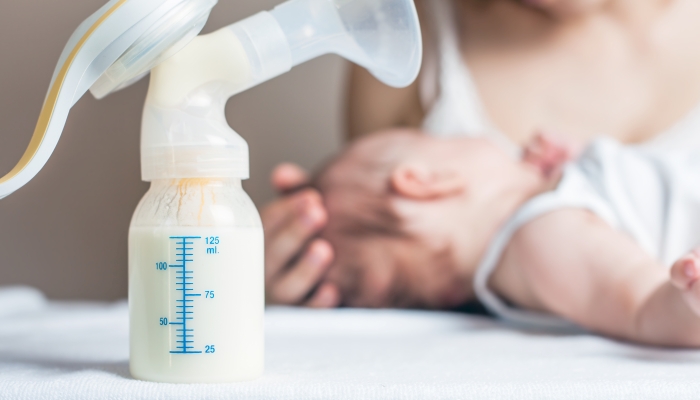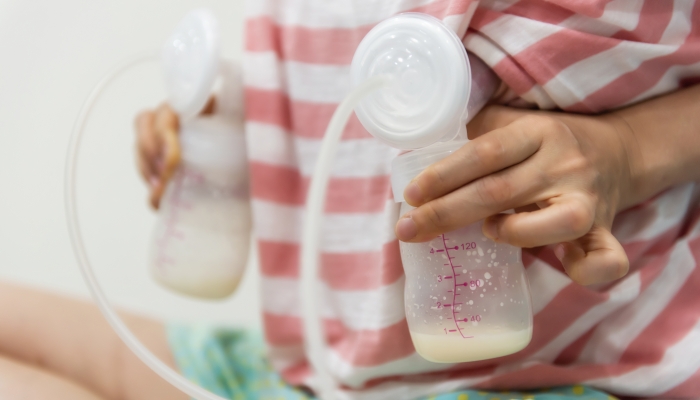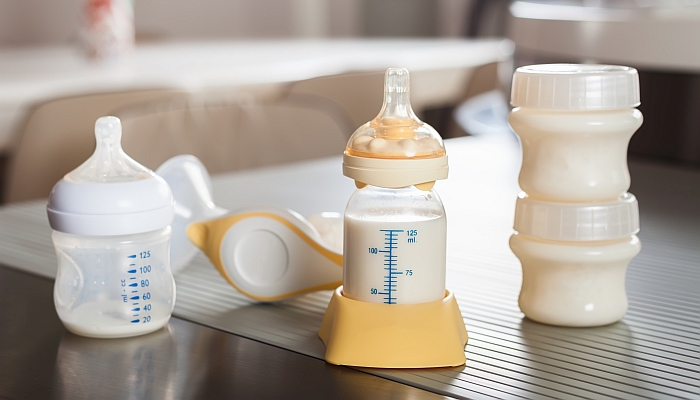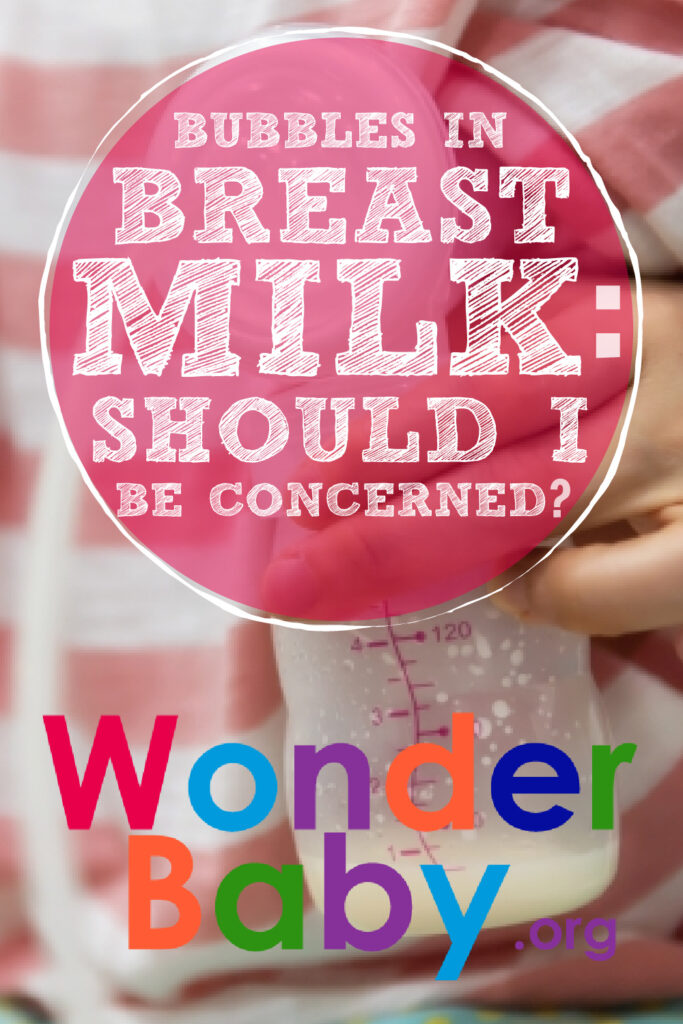Bubbles in Breast Milk: Should I Be Concerned?

- Bubbles in breast milk can form as a result of how it’s handled, the letdown reflex, how it’s stored, soap residue, or malfunctions with your breast pump.
- Bubbles can upset your baby’s stomach, so it is best to avoid feeding your baby air bubbles.
- Bubbles in breast milk don’t indicate that the milk has soured.
- Breast milk will sour with improper storage and will have a rotten smell and/or taste to it.
When you pump breast milk, you may notice that it looks very similar to cow’s milk. You’ll also see air bubbles in the breast milk sometimes. You may start to worry about how you are going to remove air bubbles from this liquid gold you finished pumping. Bubbles in breast milk aren’t a sign that the milk has gone bad, thankfully. There are a variety of reasons that can explain why your breast milk has bubbles in it. Letting your baby consume many bubbles can lead to minor gut annoyances, though.
Why Does My Breast Milk Have Bubbles?
There are several reasons why bubbles will form in breast milk. These include:
- how it’s handled,
- the letdown reflex,
- how it’s expressed,
- how it’s stored,
- soap residue,
- and malfunctions with a breast pump.
Handling
Human milk consists of:
- protein,
- carbohydrates,
- fats,
- water,
- and other nutrients.
The proteins in breast milk allow for air bubbles in breast milk to form. The proteins change the surface tension of the milk and create bubbles as they are shaken and come together. These bubbles don’t affect the safety of the milk, as they’re just air bubbles.
Let Down Reflex
When your baby or pump machine latches onto your breast, your body automatically begins the process of expressing breast milk. This process is known as the letdown reflex.
The letdown rate varies between mothers, which affects the speed and amount of milk expressed from the breast at a time.
Having a fast or forceful letdown rate affects both breastfeeding and pumping.
If you’re pumping or power pumping and you have a fast letdown, your breast milk will be flowing out fast enough into the pump to be foamy. Again, this may create air bubbles that don’t affect the safety of breast milk.
You should talk to a medical professional if you have concerns about your letdown reflex.
Storage
There are a variety of ways to store breast milk. The way you choose to store it can affect both how long you can safely keep it and how well you can manage air bubbles.
You can choose to store milk in the bottle provided with your pump or in a specially-made breast milk bag. If you choose a container that is hard like glass or thick plastic, you could trap excess air you could push out in thinner or softer containers.
Soap Residue
Another way bubbles can occur is if there is soap residue in a bottle or storage bag with your breast milk. These differ from air bubbles, as once soap bubbles occur, you can’t get rid of them.
Breast Pump Issues
Malfunctions and other issues with your breast pump can create bubbles. If there are loose connections in-between the components, this will affect the suction from the machine and the flow of milk coming from your breast. This can lead to the formation of bubbles due to the introduction of extra air into the milk.

Can Breast Milk Bubbles Affect My Baby?
While bubbles in breast milk aren’t an indicator that it’s unfit for consumption, they can affect your baby if they consume a considerable amount.
There isn’t a hard and fast rule as to how many air bubbles are too much. The best way to think about it is, the more air bubbles your baby consumes, the more likely an upset stomach is to follow a feeding. Those air bubbles get trapped in your baby’s gastrointestinal tract and cause problems ranging from minor discomfort to potentially dreadful colic.
Symptoms of colic include:
- Hours of crying or fussing with no obvious cause
- High-pitched crying
- Very difficult to calm down
How to Prevent or Get Rid of Bubbles in Breast Milk
Handling
To prevent air bubbles while handling a bottle or storage bag, how much you shake or agitate it. To remove bubbles already present, try gently stirring the milk around with a spoon.
Storage
There are breast milk bags that can be vacuum sealed for decreasing storage space and removing air bubbles. Be aware that the specialty breast milk bags do come at an extra cost, so these may not be the best option for your budget.
To avoid air bubbles, you can also use the breast flanges to pour the milk into the bottle or storage bag instead of directly into them.
Soap Residue
Soap bubbles are impossible to get out once they are present, so the best way to deal with them is to get rid of all soap residue. Soap residue can be hard to see, so it’s best to thoroughly rinse any breast milk bottles or storage bags that will hold your breast milk. Also make sure your hands are rinsed well when handling breast milk, as you may inadvertently add traces of soap along the way.
Breast Pumps
To avoid bubbles, always ensure that any cleanable part of your breast pump is rinsed well, as they can hold onto soap residue. Ensure all connections in your pump aren’t loose as well.

How Do I Know If My Pumped Milk Is Bad?
Pumped milk will go bad with time and/or improper storage, so it’s important to double-check your breast milk before your baby drinks it.
Smell
Breast milk naturally has a different smell compared to cow’s milk since they are composed of different nutrients. Before you feed your baby, smell the milk. If it smells rotten, like out-of-date cow’s milk, then you should toss it. If you are in doubt about the smell of the breast milk, go ahead and throw it away.
Taste
Breast milk naturally has a different taste compared to cow’s milk. Breast milk is perfectly safe and healthy, so taste-testing won’t harm you. You may not be keen on tasting your own milk, however, which is fine. If you do decide to taste-test it, take a small drop and see if it has a sour taste similar to rotten cow’s milk. If it does or if you are in doubt of the taste, then throw it away.
Storage
When it comes to storage, location and temperature are the two key components of keeping stored breast milk as fresh as long as possible. You may choose to keep your breast milk in the fridge, freezer, or neither. Frozen breast milk, refrigerated breast milk, and room temperature breast milk keep pumped breast milk safe to drink for different amounts of time.
Below is a table showcasing the safe limits for storing breast milk according to the CDC.
| Countertop 77°F (25°C) or colder | Refrigerator 40°F (4°C) | Freezer 0°F (-18°C) or colder | |
| Freshly Expressed or Pumped | Up to 4 Hours | Up to 4 Days | Preferably within 6 months, but up to 12 months is acceptable |
| Thawed, Previously Frozen | 1–2 Hours | Up to 1 Day | NEVER refreeze milk after it has been thawed |
| Leftover from a Feeding (baby did not finish the bottle) | Use within 2 hours after feeding | Use within 2 hours after feeding | Do not freeze leftover milk |
FAQ
Does breast milk bubble if shaken?
If you were to shake a bag or bottle of breast milk, you would make the breast milk foamy. What causes this to occur is the protein found in milk and its ability to change the surface tension of milk.
I’m leaking breast milk at times other than when I’m breastfeeding or pumping. How do I deal with these leaks?
While your baby latching on may be the primary trigger of the letdown reflex, other outside factors can trigger it. If this happens, you’ll express milk when you least want to.
One way to help with untimely milk expression is to use breast pads. Just be aware that they only last for so long and need to be changed out.
For storing breast milk, does it matter if it is a full-size or miniature fridge?
While the size difference between full-size and miniature fridges is certainly a factor in which fridge you choose, temperature control is a huge factor.
The table from the CDC that’s found earlier in the article has particular temperatures for the refrigerator and freezer. If the temperatures needed to store frozen milk or refrigerated milk are present in the size of the fridge you need, then you can narrow it down to what fits your needs specifically.
If you’re interested in purchasing a mini-fridge, click the link so you can search for the one that fits your needs the most.

Related Posts

Breastfeeding, Sleep
Sleep and Breastfeeding: A Comprehensive Guide for Nursing Moms
Many people assume breastfeeding and sleep training don’t go together, but it is possible to help your baby sleep better while continuing your breastfeeding journey.

Breastfeeding
Comfort Nursing: Pros, Cons, and How to Stop
Find out what comfort nursing is, when should you worry about it, and how to stop or limit your baby's comfort nursing (especially at night!).

Breastfeeding, Product Reviews
5 Best Breastfeeding Chairs for Nursing Moms of 2023
Whether you want a gentle rock, a smooth glide, or a cozy cuddle to soothe your baby to sleep, you’ll have your pick of the best breastfeeding chairs on the...